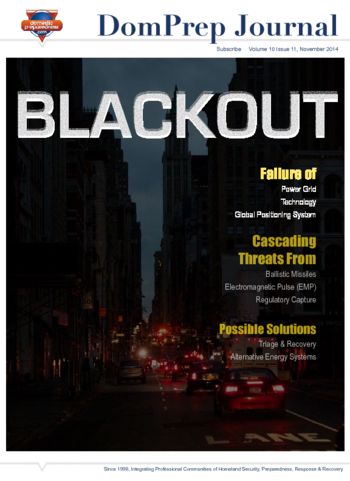
Em-Powering Communities to Prepare
Catherine L. Feinman
November 26, 2014
Modern society has become dependent on electrical resources that sustain communications, transportation, agriculture, finance, water, sanitation, and other aspects of daily life. As such, a catastrophic failure of the electric

Community Preparedness for Power-Grid Failure
Mary Lasky
November 25, 2014
Loss of the electric power grid could cause cascading effects following a major disaster. By working and planning together, individuals and communities will be better prepared and more resilient when faced with any disaster. As communities plan for major disasters, they also will be better prepared for not-so-major incidents.

Electromagnetic Pulse Triage & Recovery
Charles (Chuck) Manto
November 25, 2014
There are immediate and long-term steps – planning, triaging, and shielding – that any organization can take to mitigate disasters related to electromagnetic pulse (EMP). Understanding how EMP works, benefits and types of protective actions, as well as standards and ratings will help simplify the process of protecting civilian critical infrastructure.

Major Management and Performance Challenges Facing the Department of Homeland Security
Domestic Preparedness
November 21, 2014
The Department of Homeland Security (DHS) must continually seek to integrate management operations under an authoritative governing structure capable of effectively overseeing and managing programs that cross component lines. This

Grid Power Failure - Alternative Energy Systems That Work
William Kaewert
November 19, 2014
As businesses and residents examine alternative energy sources in light of long-term power outage threats, some important features must be considered. Ensuring that a system is able to operate off grid requires that it operate completely independently, have a manual or automatic transfer switch installed, and include either on-site energy storage assets or a fuel-consuming generator.

Maine - A Journey Through State Grid-Protective Legislation & the Threat of Regulatory Capture
Andrea Boland
November 19, 2014
Government officials in Maine are taking steps to protect the electric grid from severe geomagnetic disturbances and manmade electromagnetic pulse weapons. However, ensuring that state agencies and electric utilities work together toward a common goal can be a challenge. The final task force report on emergency legislation passed on 11 June 2013 is expected later this month.

Satellite Navigation & Timing: Good News, Bad News
Dana A. Goward
November 19, 2014
The Global Positioning System is an integral part of the U.S. critical infrastructure. However, its importance may not be realized until the system fails. It is important to examine the good and the bad of satellite navigation and timing when discussing: current systems, vulnerabilities, satellite signals, cost, implementation, and government efforts.

Challenge: Defeat Ballistic Missile Attacks From the South
Henry (Hank) F. Cooper
November 19, 2014
When President John F. Kennedy announced that Soviet ships were transporting nuclear weapons and
ballistic missiles to Cuba, U.S. citizens prepared to “duck and cover” as they had been taught in grade
school. Individuals and families were more self-reliant in the 1960s than today. With greater reliance
on electricity, all Americans are now even more vulnerable, especially to the electromagnetic pulse
(EMP) from a high-altitude nuclear burst.

Washington, D.C. - Fail Gracefully, Recover Quickly
Rodrigo (Roddy) Moscoso
November 11, 2014
In the nation’s capital, emergency managers identify hazards, consider location-specific elements, and implement lessons learned from past incidents in order to create a robust preparedness plan for critical infrastructures, including power and water. Efforts in neighboring jurisdictions and private sector cooperation also contribute to the regional resilience of the power grid.

'Old-School' Response to Medical Emergencies
Joseph Cahill
November 10, 2014
This current emergency medical services (EMS) dispatch and response process has evolved significantly over the past few decades. A dispatcher records the details of a 911 call in a web-based application. That information flows through a computer terminal into an ambulance. The unit responds using directions from a global positioning system unit on the vehicle’s dash. Emergency medical technicians use a wireless tablet to complete an ambulance report. Finally, the report is uploaded to a secure cloud over a virtual private network, where hospital staff as well as EMS headquarters can access the data in real time.






